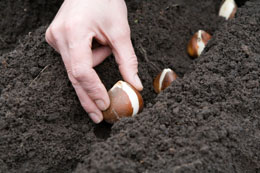If it's a tulip you plan to plant this year, then it's important to learn about the best time to plant the bulbs and how to take care of them. This article gives you tips for the same.

Tulip, an upright showy flower belongs to the family
Liliaceae, is one of the hundred bulbous species found under this genre. It is found growing in many regions of Europe, north Africa, and Asia. Tulips come in almost every color possible, a garden full of tulips, like the famed
Keukenhof Gardens, Holland, leaves most people spellbound. Row upon row of these beauties will leave you speechless.
Tulips are propagated through seeds, offsets, and bulbs. Bulbs are the most common and easiest way to grow them. Tulip bulbs should be planted around September or early October, around autumn or fall, and before the first frost sets in. Your tulips will bloom in spring; April or May. Being perennial, they will bloom every year in spring. The best time to plant tulips would be in autumn, for a spring bloom, the month could vary depending upon which hemisphere you live in.
Planting Tulips
Once you have decided to plant your tulip, it is time to decide upon the color and the
cultivar. Tulips do very well in pots too, but their real beauty is very pronounced when they are grown in flower beds, color coordinated, row upon row, or in an interesting even an offbeat shape. It is best check which USDA hardiness zone you live in, and then get on with the planting.
Tulips need lots of sunlight to bloom and for their colors to come true. They will survive the winter, but never bloom in it. Choose healthy bulbs, they should be large in size, with no fissures, or signs of rot or black fungal mold on the outer side of the bulb. The bulbs should feel firm, never soft or squishy. If you are planning to plant it in pots or containers, then soil and water can easily be controlled, however, if it is a spot in the garden, choose a location that receives ample sunlight and the soil does not log water. The soil should be well prepared before you start planting the bulbs or corns. Weed the soil well, loosen it, the roots that sprout from the bulbs should have a free spread in the soil. Dig and loosen the soil deep. Porous soil will aid in adequate air circulation to the bulbs. Mix the soil with compost, peat moss or fertilizers, and level the surface.
For planting tulip bulbs, dig a hole approximately four or six inches into the soil. Place the tulip bulb's flattened side (wide base) down and pointed end up. Space them five to six inches apart and in symmetry. Press the bulbs very gently in the soil, to ensure they are standing in an upright position. Back-fill the hole, and water lightly. Withhold watering until the leaves begin to sprout from the ground. Bulbs need moisture to promote growth, but excess water will set rot in the bulbs and cause them to have a stunted growth, or they will never sprout. Winter care for tulips will involve a light cover of mulch and very restrained watering. Mulch will keep the soil warm and little water will keep the bulbs moist.
After Planting Care
Once planted, tulips require very little care until spring arrives. Early spring, remove all mulch and let the soil soak up the sunlight. A very light digging around the tulips is recommended to de-weed, if any. Feed water-soluble fertilizers that are specifically designed for bulbs to promote growth. Healthy leaves are a sign of a healthy bloom. Once your tulips start to bloom, keep a watch out for aphids. Aphids have quite a bit of fondness for tulip blooms. They can not only damage the flowers, but the whole plant including the bulbs as well. Either remove the infected tulip plant or mist it with aphid specific germicide. Cut out faded blooms to promote growth. Once the flowering season is over, leave the bulbs in the ground or use appropriate tulip bulbs storage method to ensure a good growth next season.
Given good conditions, most blooms will last almost a month. Once you know the right way to plant tulips, go ahead and get yourself these splendid blooms.






 Tulip, an upright showy flower belongs to the family Liliaceae, is one of the hundred bulbous species found under this genre. It is found growing in many regions of Europe, north Africa, and Asia. Tulips come in almost every color possible, a garden full of tulips, like the famed Keukenhof Gardens, Holland, leaves most people spellbound. Row upon row of these beauties will leave you speechless.
Tulip, an upright showy flower belongs to the family Liliaceae, is one of the hundred bulbous species found under this genre. It is found growing in many regions of Europe, north Africa, and Asia. Tulips come in almost every color possible, a garden full of tulips, like the famed Keukenhof Gardens, Holland, leaves most people spellbound. Row upon row of these beauties will leave you speechless.